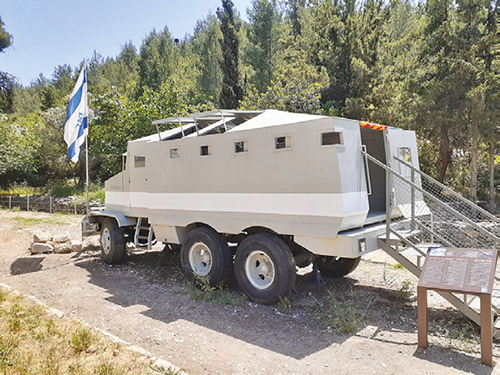

Today as we drive on the newly expanded Highway 1 from Tel Aviv to Jerusalem, it is difficult for us to imagine that on November 29, 1947, the day after the United Nations Partition Plan enabling the establishment of the Jewish State, this road was impassable. Arab forces blocked the then narrow road and fired on Jewish soldiers, blocking their advance to Jerusalem with food and medicine needed for the isolated residents of the City.
When driving along this road, you may recall seeing a lineup of several old army vehicles placed as a memorial to those lost in the battle for Jerusalem during the 1948 War of Independence. Just last year, on March 23, 2021, in a tribute to this heroic battle, a memorial museum was opened at this historic location.
Called the Khan Sha’ar HaGai museum, the creative, state-of-the-art exhibits are housed within a khan, or way station, built by the Turks at the end of the 19th century to provide accommodations for pilgrims traveling from Jaffa to Jerusalem. When it was built in 1873 the structure included a ground floor with stables, a bakery, a vaulted courtyard and an orchard. The new museum preserves much of the original structure, giving it the flavor of the original roadside hostel where pilgrims rested and recovered from their journey.
Sha’ar Hagai, translated as Gateway to the Valley, or as it is famously referred to in Arabic as Bab el-Wad, is located where the original road from Tel Aviv to Jerusalem began to ascend through a deep valley flanked by steep, rocky slopes. During the War of Independence, the Arabs realized the potential of this narrow stretch of road for ambushes with the goal of preventing supplies from reaching Jerusalem. In reaction, a decision was made among Palmach commanders to gain control over the area. Convoys were accompanied by armored cars to force their way to Jerusalem.
However, these protective armored cars were created of thin, tin sheeting, which was not at all effective in protecting against the barrage of weapons coming from the hills alongside the road. The tale is told about an attack on a vehicle carrying live fish. The covering of the vehicle was so thin that holes were bored into its sides. To prevent the spoilage of the needed food, women from a nearby kibbutz ran out with rags to stuff into the walls of the vehicle and preserve the shipment of fish.
Through great courage and determination, the Burma Road was cut through the mountains to bypass the siege and allow the convoys into Jerusalem. The Palmach fighters captured Bab el-Wad, but the section west of it remained in Jordanian hands until 1967 when, during the Six-Day War, the entire area was captured by Israel and the main Tel Aviv-Jerusalem Highway was constructed once again.
The new Khan Sha’ar HaGai museum, which is managed by Israel’s Nature and Parks Authority, tells the story of the heroic legacy of the Palmach soldiers and regular civilians, some of whom were merely teenagers and recent survivors of the Holocaust. Their story is told through five interactive stations. In one, the visitors are asked to make decisions about situations faced by the fighters regarding food deliveries versus weapons. At another station, visitors hear firsthand testimonies of actual fighters. Visitors enter an actual armored vehicle from the period to understand the threats faced by the fighters in getting through to Jerusalem. Actual artifacts from the period are displayed throughout the exhibits.
This new museum is one additional example of Israel’s creativity and innovation in creating museums and heritage centers that pay tribute to key events in its history through compelling and technologically sophisticated exhibits.
The Khan Sha’ar HaGai museum is recommended for those ages 10 and above. The complete tour lasts for 90 minutes. For location, visiting hours and price of admission go to https://en.parks.org.il/reserve-park/gay/
By Pearl Markovitz










